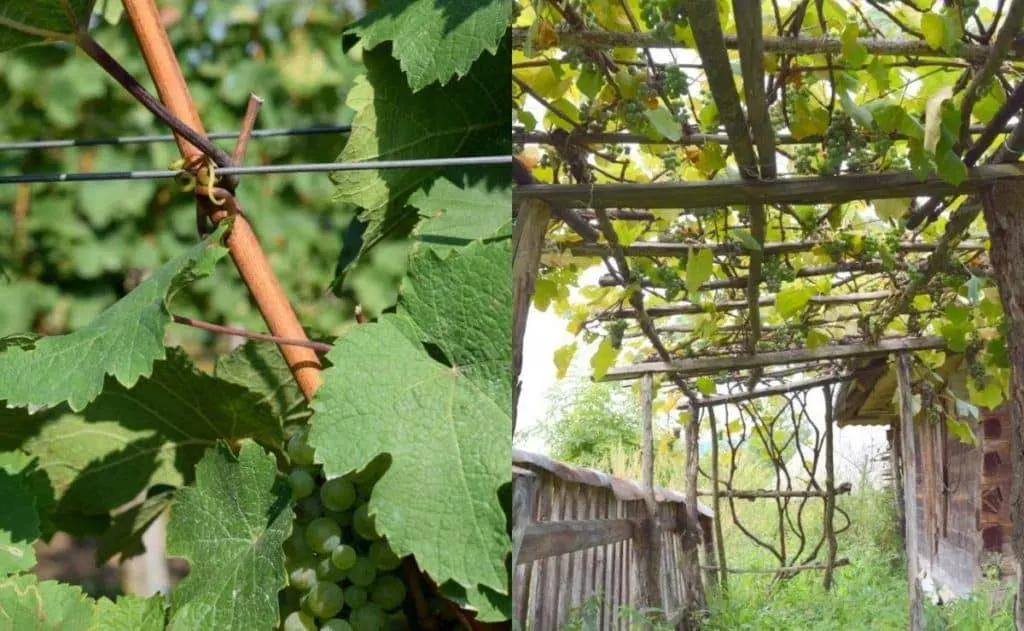
Grapes can be one of the most rewarding crops in your garden!
The bunches are beautiful, sweet and slightly sour, absolutely delicious, and being such prolific growers, they will provide for your fresh grape consumption year after year.
If you have plenty of space, you may even get into making your own wine or grape must.
One of the best things about grapes is that they are a perennial, so you only need to plant once.
That being said, location is everything. Plant grapes into your vertical garden and you will be rewarded with a natural privacy screen, or shade, that smells wonderful with its early blossoms.
Consider this: grapes are going to climb whatever they can, be it a building, a tree, or a pergola. And they will run wild if you don’t prune them back in both winter and summer.
That’s why we train them to grow a bit more orderly with a trellis.
Is a trellis necessary to grow grapes?
If you’ve ever come across wild grapes from an abandoned orchard/vineyard or old homestead, you will find that grapes are survivors, often outliving their caretakers.
With proper care, tenacious grapevines may live to be 50 years old, even growing till way past 100.
While 60% of grapevine roots sit in the top two feet of soil, they can extend down into the Earth to a depth of more than 20 feet!
Where there is a will, there is a way. If no trellis is present, grapevines will climb wherever they can, even covering an entire home or a fruit tree.
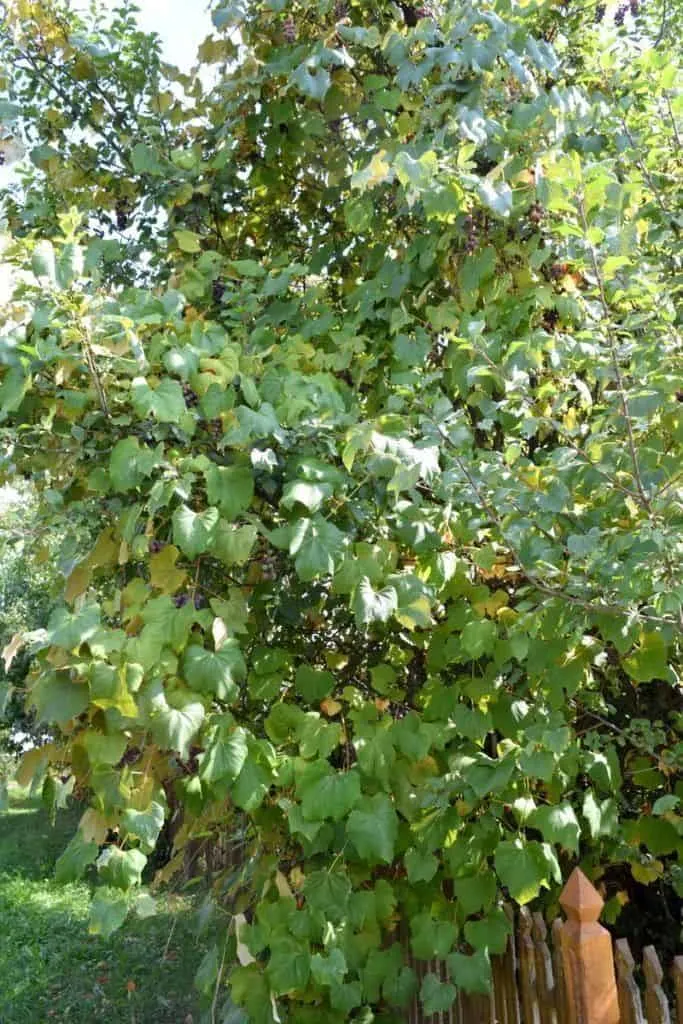
But that makes harvesting more difficult, and the grape bunches may be more prone to disease as they grow nearer to the ground.
For the healthiest grape crop possible, a sturdy trellis is the best way to go.
If you are just starting out, know that it takes about 3 years for new vines to start producing fruit, but it is worth having the trellis in place so you can guide the vines gently season after season.
Supporting your grapevines
Grapevines grow far and fast in a single season, sending out side shoots (called tendrils) to help them climb along their way.
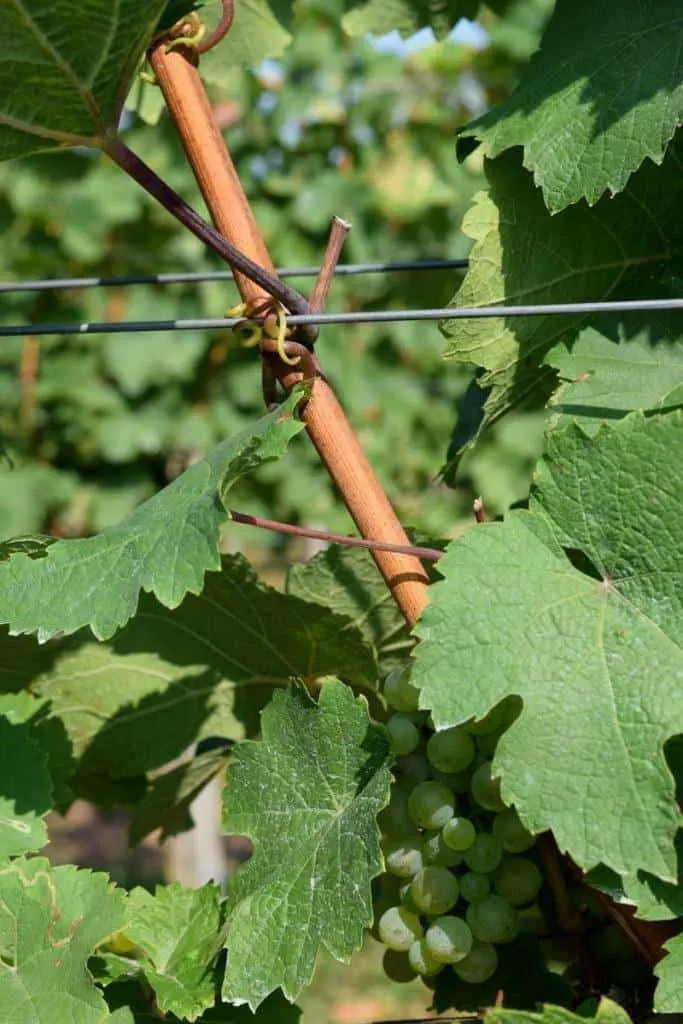
The weight of a fully mature vine will be hard for some smaller structures to bear, that’s why trellises need to be built sturdy from the start.
If you are growing wine grapes, do as most vineyards do and plant lines of root stock that follow a supported system of posts and wires. Come pruning and harvest time, you will find out why this system works best.
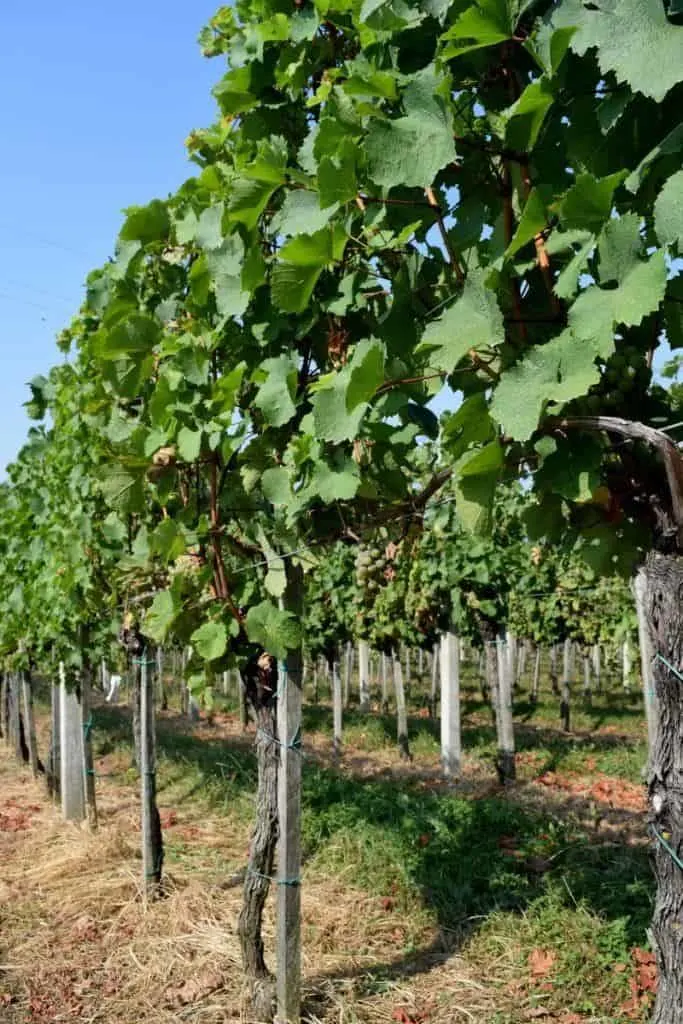
For the backyard grape grower a well-constructed and placed pergola is a wonderful way to grow grapes.
It only takes one, two, or three vines to cover a generous space, which will provide you and your family with more grapes than you could ever eat at once! The rest is for sharing, making grape must and jelly.
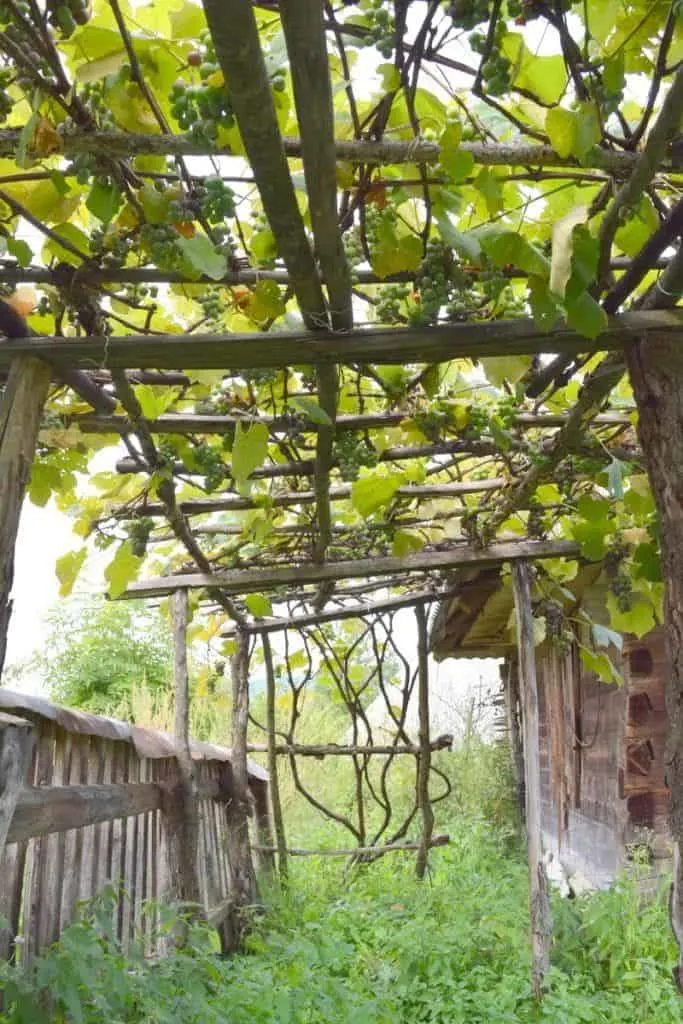
If you’d like to make your own structure for growing grapes, you will find plenty of plans online.
This Simple DIY Pergola from APieceOfRainbow.com is a great place to start.
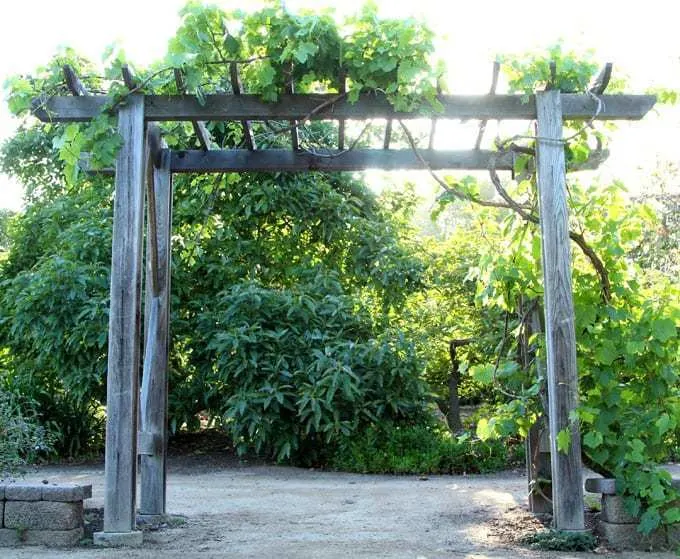
A simple grapevine support
If you have a small garden, there is no reason you can’t grow grapes. Use a small structure as a dividing wall, and train the vines to follow the posts and wires.
Here is an example as to how simple it is to grow grapes right outside your door:
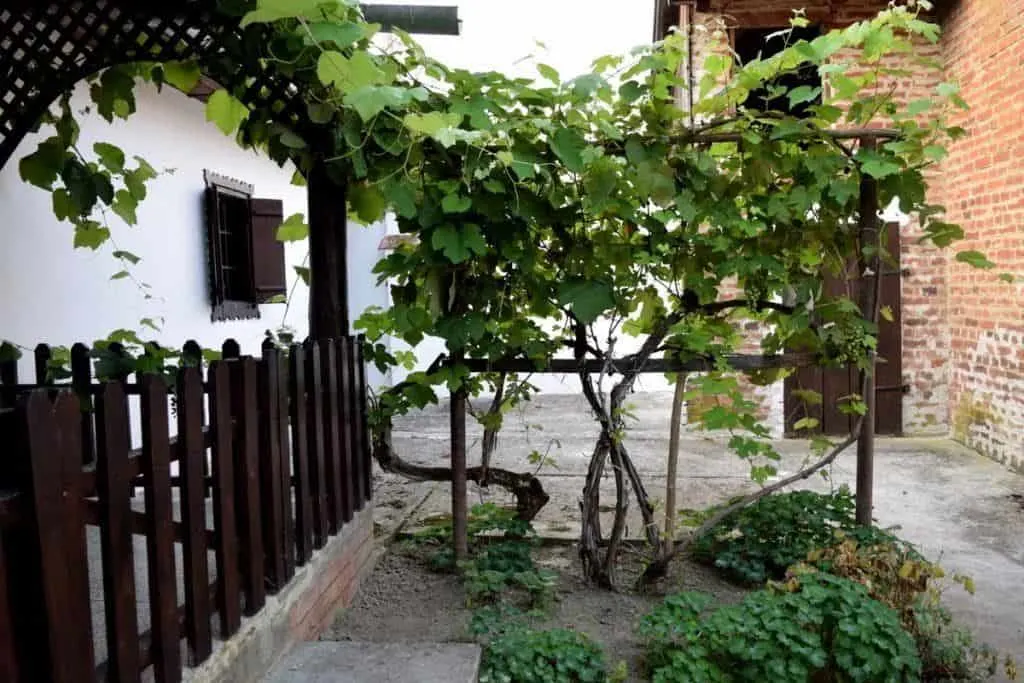
How tall should a trellis be for grapes?
Well, that depends. If you intend to cover your yard or patio with it, think of all the activity that happens underneath. Do you wish to dine under the leaves? Will you be sitting in the shade or will you be standing?
Your backyard activities will determine the height your pergola/trellis needs to be.
For example, our trellis is about 7′ off the ground. It is the perfect height for pruning and harvesting without a ladder, but an adult cannot stand under it without brushing their hair with grapes.
If you wish to enjoy your pergola year-round, set your sight to 10′ high for maximum comfort. Naturally you will need a ladder for harvesting, however since grapes are usually harvested several bunches at a time, this is not a problem.
How to trellis grapes
Once you have decided that grape growing is for you, you’ll first want to seek out the best varieties that grow in your hardiness zone.
Plant new grapevines at the same time you install a trellis that suits your garden space. The size difference may seem strange, but do it anyway and imagine the overabundance of grape bunches 5 years down the line.
In the beginning, you will need to tie up young plants, until they are tall enough to hang on themselves. Plant grapes where you wish them to stay. Grapevines can be transplanted, most successfully when they are young.
Keep in mind that grape vines can become very thick – to handle the excess weight, use a support system in combination with heavy winter pruning that will hold your vines up in any weather.
6 reasons to grow grapes in your backyard
Once your grapevines (and your trellis) is well established, grape growing is so simple – let them multiply and spread almost all by themselves! A bit of selective pruning never hurts the vines, or the fruit.
If you dream of harvesting your own bunches of sun-warmed and ripened juicy grapes, why wait with planting your own?
Wherever you are in the world, there is a great chance that some variety of grape will grow. Choose from the following popular varieties or invest in an heirloom variety to save for future generations:
- Concord
- Pinot Noir
- Valiant
- Sweet Jubilee
- Crimson seedless
- Riesling
- Fry Muscadine
Read this guide of 15 Types of Grapes To Know, Eat And Drink for more information on choosing the best grape variety for you and your homestead.
1. Pick grapes at their peak ripeness
We all love bunches of perfectly formed grapes, but truth be told, fresh from the vine is best.
If you have plenty of sunshine, well-draining soil and know how to prune grape vines and leaves to aid in summer air circulation, that’s all you really need. Find a grape variety that is hardy in your climate and you will be set with grapes for life.
Just think of all the grape jam, juice, jelly and raisins that you could make at home. Of course, don’t forget about the grape leaves for stuffing and pickling.
2. Abundance in a small space
If you have a small yard or garden, grapes are a perfect crop of choice if you also want to sit in their shade (imagine a nicely covered pergola with table and chairs underneath, filtered light and good company with a glass of lemonade or wine…).
It only takes a few mature vines to produce a generous amount of fruit. One grapevine can offer 20 pounds of grapes in average, each harvest season.
3. Longevity
We mentioned above that grapevines can live to 50 years and more – did you know they can still be producing at that age?! Grapes are more than just a pretty plant, they are also food for thought and contemplation. It also turns out that they have quite a return on investment.
If you are patient and loving, your vines will be producing for decades to come.
4. Drought-tolerant and beautiful too!
Grapevines have a deep tap root which helps them to thrive in hot, sunny locations. If your local climate has extended periods of rainless days, and you just happen to like eating grapes, then this may be the perfect perennial for you.
When you are seeking refuge from the blistering sun, a leaf canopy of dense grape leaves will provide the most spectacular shelter.
5. Grapes attract beneficial insects
Not only will your grapevines be buzzing with bees, they will attract a whole suite of beneficial insects ranging from lacewings to lady beetles.
If you allow yarrow, Queen Anne’s lace, dill or fennel to blossom nearby, you will entice parasitic wasps to fly by too.
6. Benefits inside and out
Grapes are an excellent source of vitamins A, C, B6 and folate. They also contain essential minerals such as iron, calcium and potassium, making them one tasty bunch of natural vitamins.
Don’t forget about the phytonutrients (resveratrol) and the fact that they spruce up the landscape in all seasons. Autumn is the winner in terms of color and contrast, though the vines in winter provide a stark contrast to white snow.
No matter what the season, grapevines are a pleasure to have in the garden.
Now only if harvest time came a little faster!
Read Next: How To Summer Prune Your Grape Vines

Get the famous Rural Sprout newsletter delivered to your inbox.
Including Sunday musings from our editor, Tracey, as well as “What’s Up Wednesday” our roundup of what’s in season and new article updates and alerts.


